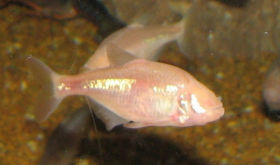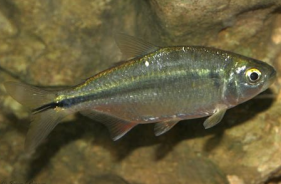Master Internship and PhD Proposal
15 Oct 2023Power Production in living systems: a biomimetic model of optimisation constrained by resource management
LIED — Université Paris Cité, 35 rue H. Brion, 75013 Paris
contacts: eric.herbert@u-paris.fr , christophe.goupil@u-paris.fr , patrick.laurenti@u-paris.fr
  |
|---|
| Two morphotypes of the same species, Astyanax mexicanus. On the top the blind and depigmented cave morphotype, on the bottom the surface morphotype. |
Master internship
We propose a master internship at the interface of physics and biology, supervised by biologist and physicist, to study the adaptation of the power production mechanism of animals to the environment.
Power production
The power production mechanism, for example dedicated to locomotion, is a general and vital process based in the animal world on the degradation of ATP molecules during the Krebs cycle. However, this common process, far from freezing the modalities of use and power production of living systems, adapts to the specific environmental constraints encountered by each population.
More specifically, we are interested, in a biomimetic approach, in the adaptive optimisation of energy conversion systems according to the constraints imposed on access to resources.
To this end, we are developing a theoretical and experimental approach, deriving the well-known formalism of non-equilibrium thermodynamics to living systems and relying on the description of biological mechanisms of metabolism, and in particular oxygen consumption. This allows us to reconstruct the energy flows through the organism and to characterise it quantitatively using generic parameters allowing inter-individual comparison.
Although our approach has so far focused mainly on mammalian species (in particular the horse, see ref below), the development of simple metabolic characterisation tools allows us to consider broadening the range of species studied. Following preliminary work carried out in the laboratory, we have designed a device (swimming tube and sensors) to record the consumption of dioxygen of actinopterygian fish. In order to limit the effects due to genetic variability, we propose to compare morphotypes of the same species. We have chosen Astyanax mexicanus, a species in which there are two separate but interbreeding populations: a surface morphotype, a predator with a very vivacious behaviour, and a cavernicolous morphotype, a detritivore with a placid behaviour. In addition, we propose to conduct a phylogenetic analysis that will allow us to describe the evolution of biological processes that determine the ability to produce and sustain effort in all vertebrate animals; and, in particular, to characterise the evolution of mechanisms of adaptation to effort during the transition from aquatic to terrestrial life in the vertebrate lineage as a bioinspired model of adaptive transition.
To know more about it, see
Herbert et al. Thermodynamics of Animal Locomotion. Physical Review Letters 125, 22 (2020): 228102. https://doi.org/10.1103/PhysRevLett.125.228102
Goupil et al. Thermodynamics of metabolic energy conversion under muscle load, New J. Phys., vol. 21 (2019), https://iopscience.iop.org/article/10.1088/1367-2630/ab0223
[— Possibility of continuing to a PhD —]

